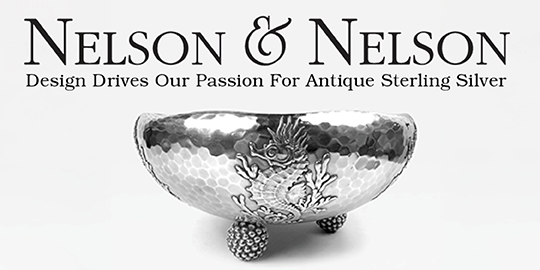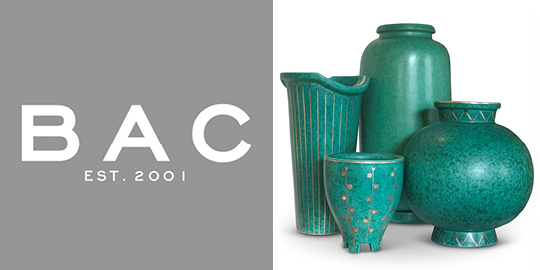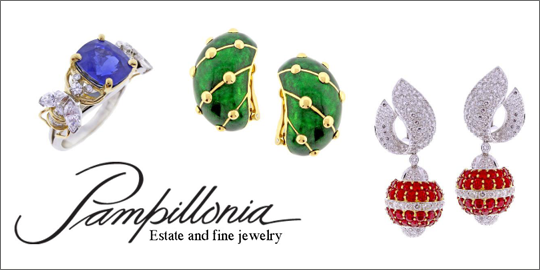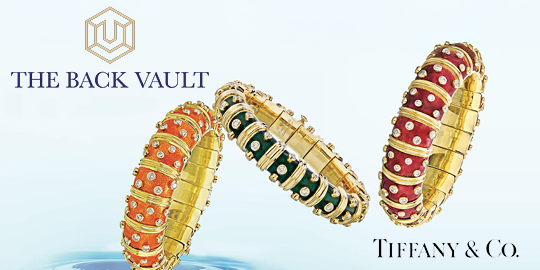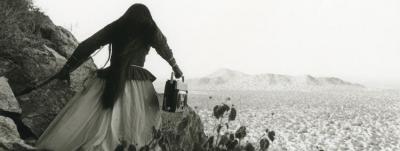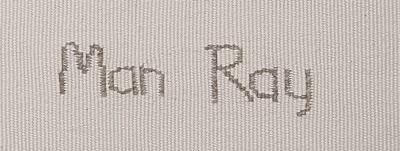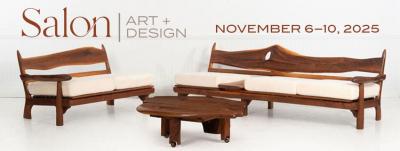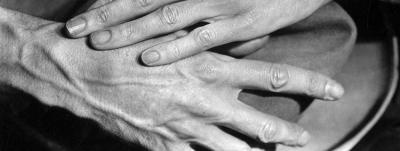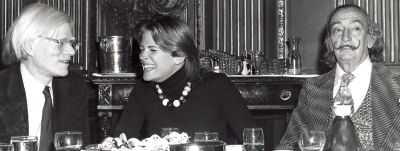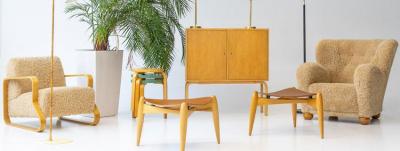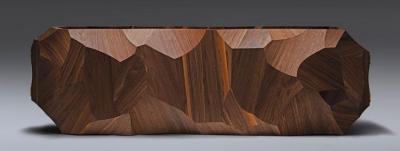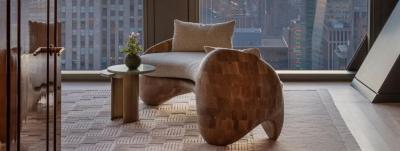Eagles and Tulips, Snakes and Weathervanes
A Pennsylvania Folk Art Collection
Behind the facade of a sprawling Mid-Atlantic stone house is one of the foremost collections of American folk art. Exuberant color and an affinity for sculptural and playful forms characterize this astonishingly layered gathering of objects. The common element uniting this collection is the extraordinarily fine quality of every piece. The collectors have meticulous instincts and have sought out the very best.
The adventure begins at the front door, which opens to an entry hall that is a blaze of color, the result in part of painted leather fire buckets that line the stairs and a pyramid of parade fire hats; a rare Shaker shelf clock and tailoring counter act as subdued foils. The ensemble hints at the treasures beyond. It is fitting to see Shaker pieces upon first entering the house; the couple began their collection acquiring furniture crafted by Shaker artisans whose intent was to create works of beauty and perfection.

- A portrait of a child in a pink dress wearing coral beads and holding a squeak toy was painted by Zedekiah Belknap (1781–1858) in 1830. Below the portrait, the couple has arranged a vignette with objects similar to those seen in the picture, including an identical child’s toy. Charles C. Hofmann’s (1820–1882) View of Schuylkill Almshouse Property, 1875, the earliest known view of that institution, hangs on the adjacent wall. It is one of several almshouse pictures in the collection. The Shaker ministry chairs from the Harvard, Massachusetts, community have caned seats and are especially fine. The Shaker tall clock, circa 1810, is by Benjamin Youngs (1736–1818) of Mount Lebanon.

- The collection includes no fewer than three dazzling Mahantongo chests. One, a rare pine and poplar blanket chest with two drawers attributed to Johannes Mayer (1794–1883) is painted with praying children in red capes, facing birds, and a potato stamp border. A rare green four-drawer chest decorated with two pairs of angels came from the Garbisch collection and is dated 1835. The third, a child's chest is noted above. Several of the animal carvings are attributed to German woodcarver Wilhelm Schimmel (1817–1890). The compelling portrait of a woman in a blue dress with wide sleeves is unsigned and nothing is known about the artist or the sitter. The picture on the adjacent wall depicts a firefighter holding a speaking trumpet and pointing to a fire. His hat, cape and belt buckle are marked “Liberty.”
Their first house was a modern residence in New Jersey — “complete with shag rugs,” the wife says with a smile. The couple had been living without a dining room, using as their eating surface a table the husband had made from a door when in medical school. When they converted their garage to use for entertaining, the wife saw her opportunity. She showed her husband a photograph in a magazine of a Shaker table surrounded by ladderback chairs and told him that this was what she wanted for the new room. He responded, “Why do you want that old stuff? New furniture is just as good.” He challenged her to do some research and learn more about the table and chairs. She did just that. Armed with information about the Shakers, their furnishings, and the quality of antiques, particularly in comparison to new furniture, they located what they were looking for at an antiques shop. When making the delivery the dealer brought along some other Shaker pieces and by the time he left they had nearly outfitted the entire dining room and the couple was off and running. The wife laments today, “I created such a monster, I can’t tell you!” In the intervening years, the couple has brought together a first rate collection that is the envy of many a museum. Continually upgrading, they have owned four Shaker dining tables. At present, a long trestle table accommodates friends in the dining room, and a Hancock trestle example in curly birch described by some experts as the “all time best Shaker table,” has been moved to the barn because it is too small for dinners.
The collection includes an array of Shaker furniture: a twelve-drawer tailoring counter, circa 1860, from Mount Lebanon, along with exemplary cupboards, chests and desks, tables, chairs, household implements and storage boxes, dry sinks, painted tubs, large painted bowls, scoops, and stands. Shaker clocks include three New Lebanon examples: a rare, signed poplar tall clock made by Amos Jewett (1753–1834) in 1809; a cherry example, circa 1810, with an eight-day wooden movement by Benjamin Youngs (1736–1818); and a rare, circa-1820, dwarf tall-case alarm clock with cast pewter gears attributed to Isaac Newton Youngs (1793–1865) (shown in the front entry).

- The carved pine flight of three angels from St. Luke’s Lutheran Church in Schaefferstown, Pennsylvania, dates from 1765. The Mahantongo child’s blanket chest, the only one known, is decorated with two prancing horses and four birds. The rabbit is one of many carved or chalkware figures around the house; it keeps company with a wooden turtle and an exceptional sgrafitto plate decorated with three tulips and attributed to George Hubener; it is dated September 10, 1785. Its German inscription translates loosely as, “If it weren’t for the boys and the roosters, cradles and hen houses would be empty.” (This plate holds the auction record for redware; it is placed here only temporarily.) The couple uses displays of iron hinges throughout the house as decorative devices.
From the New Jersey house the couple and their three young children moved to a 1930s Pennsylvania stone residence. They transferred their collection and continued to expand it, both in size and in variety of material. Through the years of acquisitions, the couple has born in mind the advice of the husband’s mother, herself a collector of fine Philadelphia furniture: to approach collecting in a scholarly way and to study the objects before acquiring them. Though her husband initially had little interest in antiques despite growing up with them, the wife has always loved period objects, beginning with those owned by her parents, passed down from generation to generation. Of Pennsylvania-German heritage, the wife admits to a natural affinity for Pennsylvania material, finding the distinctive paint decoration highly appealing. Though continuing their interest in Shaker material, the couple has focused on exceptional Pennsylvania decorative arts, though also partial to objects from other regional centers that they find particularly strong in form and decoration.
Needing more space, the couple purchased a barn in Lebanon County, Pennsylvania. A crew of Amish and Mennonite joiners disassembled the post and beam structure and then reassembled it alongside the couple’s home in an old-fashioned barn-raising. Meanwhile, the couple designed expanded living quarters that would join the barn with the house. A large center-island kitchen with a skylight and open rafters was built to merge aesthetically with the barn interior, along with dining areas, offices, and sundry other rooms. The barn itself was given an open floor plan, which has since been filled to the rafters, literally, with folk art, cleverly hung from beams, fit among joists, or arranged on the pegged floor boards and highlighted by the streaming sun coming in through the glass front of one of the gable ends.
Extraordinary folk carvings characterize the collection, which is replete with lions and tigers, bears and birds, trade figures and trade signs, weathervanes, and decoys. In the barn, the majestic figure of Chief Black Hawk, the patriarch of the Sauk and Fox Indian nations of Kansas, is paired with an equally imposing figure of an Indian maiden. A swan boat that acts as a confidence decoy rests on the stone chimney shelf; this one-of-a-kind design was made as a floating blind by a duck hunter in the Adirondacks in the early twentieth century. Installing the boat was quite a challenge as it was raised over the course of an exceptionally steamy July day. In the den, among a fine array of Wilhelm Schimmel (1817–1890) carvings, distinctive for their characteristic exaggerated forms, large beaks, and crosshatched surfaces, is a small Schimmel lion that is the only example known in private hands. A circa 1790 carved and gilded eagle, made for the Customs House in Boston, is from the workshop of Simeon Skillin, Jr. (1756–1806). A Noah’s ark is set against a living room wall, where its collection of about two hundred carved and painted animal figures march on planks in switchbacks up the wall.

- Pictured is a small portion of the impressive collection of still and mechanical banks, which began with a son’s interest in this playful means of saving. Among the rarities is a diminutive frog that opens its mouth and accepts loose change. Only three or so of this size were made. Included in the collection are three organ banks, a large Ferris wheel bank with animals and people, an African- American baseball game, a frog riding a bicycle, and a bank depicting the U.S. Cannon firing on the ship Spain. Others include the “Hold the Fort” bank and the “Goat, Frog, and Old Man” bank, the latter is a companion piece to the “Initiating Bank, First Degree.”
In each room of the house, one, two, or more snakes can be found. Carved in wood or stone or molded in metal, they are every where. The origin of this indulgence? The husband’s sense of humor, which the children have come to share. The object of their affection? His wife, their mother. Fortunately for her sanity she has been able to endure and make light of the situation. “I hate snakes,” she says. “And so my family gives them to me as a practical joke.” Able to laugh about this she adds, “Every year for my birthday I receive another snake. Sometimes a new one will be added to the collection just to see if I will notice.”
The sculptural three-dimensionality of their folk art collection is complemented by the abstract qualities of their redware. Displayed in a room designed specifically to showcase the ceramics, the collection is in fact so refined that the couple owns several of the best examples known. Among the notable pieces is a molded slip plate by Benjamin Bergey (w. 1820–1840) of Bucks County, Pennsylvania, decorated with flowers, stars, and rosettes, and a rare Philadelphia charger, circa 1790–1810, with earthenware slip decoration. They have also collected flasks and bottles in the forms of fish, a turtle, and a man. Playful examples include a flowerpot embellished with a bird perching on a leafy branch while a cat lies in wait beneath. A nine-inch redware dog with curled tail, attributed to master redware-maker John Bell (1833–1880), of Waynesboro, Pennsylvania, holds a woven basket in its mouth.

- The couple’s colorful collection of Pennsylvania redware contains a number of outstanding examples, including what is described as possibly the finest Solomon Grimm sgrafitto piece known: a green-ground dish decorated with hearts, stars, and tulips that was made in 1824 (left plate on the middle shelf of the right side). There are also examples by Thomas Strawhen, Conrad Mombauer, and Rudolph Gerber. George Washington and Lady Liberty stove ornaments flank the fireplace, above which is an overmantel painting from a home in New England.
The couple has also gathered exemplary pieces of stoneware such as the quadruple ovoid jugs with a single strap handle made by Stedman and Seymour of New Haven, Connecticut, circa 1825; a J. E. Norton of Bennington, Vermont, six-gallon crock decorated with an eagle that has a nineteen-and-a-half-inch wingspan; and a pair of pitchers with a diamond pattern that may be an early piece by Charles Wingender (b. 1856) of Haddonfield, New Jersey.
The couple’s three children were exposed early to collecting and the interest took firm hold. Accompanying their parents to sales, they were allowed to bid when the smaller items were offered at the end. The daughter became a serious student of Americana, particularly American paintings. Exposure to auctions took hold and she is now a licensed auctioneer and specialist with Sotheby’s. One young son’s fascination with mechanical banks and toys inspired a first-rate collection that both he and his father have enhanced over the years. Two “banks” of shelves lining a den wall house the bank collection, which includes some of the very best and rarest examples. The “still” banks are generally architectural in form and are simple repositories for the coins; the mechanical banks have moving parts, sometimes humorous, that result in coins being dropped, swallowed, or slung into a slot. One cannot help but pick up a penny, gingerly place it securely on a resting point, pull a lever, and see what happens; such playfulness brings out the child in everyone. The iron toys are found throughout the house and are most frequently in the form of fire engines or other automated locomotives.

- Carved figures of a New York Knickerbocker, identical to one in the New-York Historical Society, a firefighter in parade attire, and an Indian line a brick floor hallway that extends from the barn to the house. Despite her blue dress, the figure of a maiden, from the Kahn collection, has a rather manly aspect, leading the daughter of the house to refer to her as “my sister with the five o’clock shadow.” A York County, Pennsylvania, blanket chest with fancifully turned legs has a vibrantly painted façade of flowers and is one of the best known. It faces an early nineteenth-century Virginia lawyer's cabinet. Seen in the room beyond is the collection of banks.
Interest in paraphernalia relating to fire fighting and fire fighters is the passion of their other son, who, as a child, loved to visit the local volunteer firehouse as often as he could. The parents soon began to appreciate the folky qualities of antique fire-fighting equipment and another collecting arena was born. Throughout the house are brightly colored firemen’s parade hats, fire buckets, parade banners, ceremonial horns, figures of fire house dogs, and even the real thing, a charming Dalmatian called Teddy, whose bed is guarded by a cast pot-metal Dalmatian.
Folk art relating to fire fighting is one of the couple’s most dominant areas of collecting and it expands to include other material such as weathervanes. The couple’s favorite is of a caped firefighter driving a horse drawn cart; the vane is attributed to the manufactory of J. W. Fiske in New York. A rare cast-iron plaque on the fireplace is an 1820 firemark from the Baltimore Equitable Society. There is also the oil-on-board Weccacoe [Pennsylvania] Fireman in Parade Attire, circa 1830–1840. One of the most memorable acquisitions is an 1884 sterling silver salt and pepper set in the form of fire buckets with the insignia of the Federal Fire Society, established in Portsmouth, New Hampshire, in 1789. When dealer Milly McGehee found the set at an auction preview, her first call was to the wife, who arranged to bid on them as a surprise for her husband. Meanwhile, the husband had heard about the set as well and had asked dealer Rich Rasso to bid on them as a gift for his wife. The wife was the successful bidder. Needless to say, the husband was surprised when he opened the gift, but equally daunted by the notion that he had contributed to its elevated price — they have since agreed that there will be no more surprises!
Hung in carefully selected locations throughout the house, according to their greatest effect based on subject or color combinations, are the choicest of folk art paintings. John Rasmussen’s (1828–1895) View of the Berks County Almshouse, circa 1880, depicts the institution where he and fellow German-born artist Charles C. Hoffman (1821–1882) were residents from time to time, and which became the subject of several of his paintings. The work of itinerant artist Ferdinand A. Brader (b. 1833), whose detailed pencil bird’s-eye views of farms, is also represented in the collection. The earliest known Susan Waters (1823–1900) painting, a New York portrait of two children, one with a puppy and the other with a toy wagon, hangs in a stairwell. It exhibits the naïveté for which works from her early career are appreciated.

- The bed, with its bold form and vibrant carving, is a fanciful tour de force. The crossed arrows in the talons of the carved eagle resonate with the crossed elements in the appliquéd quilt design. The carved swag on the window is one of a pair from a funeral carriage, showing that an object of strong design can translate to any situation.
Around 1806 itinerant artist John Brewster (1766–1854) painted the sons of a Portland, Maine, merchant. That of young Charles Mussey hangs above a Shaker sewing desk at the end of a hall. Other folk portraits throughout the house include a William Matthew Prior (1806–1873) portrait of a girl in a white dress wearing coral beads; Mary B. Tucker’s (n.d.) Lady Reading a Poem, and a circa-1830 portrait of Captain Sewell A. Blanchard attributed to the Borden Limner. An Ammi Philips (1788–1865) portrait in the living room depicts two children with a grey cat. An important fireboard, originally made to decorate the front of an unused fireplace in the summer, is embellished with a pitcher of flowers surrounded by smoke decoration, circa-1835. It appears to be the work of the same unknown New England artist whose fireboard is pictured in Nina Fletcher Little’s seminal work Little by Little (1998).
Marine folk art also appeals to the couple, whose collection includes a whaling log by Charles F. Cushman, dated December 11, 1840, and marked with different stamps to indicate each kind of whale taken. The Cushmans were whalemen from New Bedford and Fairhaven, Massachusetts, and one Charles Cushman was the second mate aboard the Fairhaven whaler James Munroe, with which this logbook is associated. An early hooked rug from the collection of Barbara Johnson depicts a panoramic whaling scene surrounded by harpoons, a lifeboat model, and scrimshaw. A portrait of a sea captain by John S. Blunt (1798–1835) hangs nearby, as does a framed 1887 woolie worked by W. W. Beck depicting American and French ships at sea. A cast-iron mermaid from a ship scrapped in Seattle, Washington, floats in the rafters of the barn.
Meticulous caretakers of the material that fills their home, the couple is especially generous with their collection and frequently loans their objects to museums and other institutions — although the husband confesses to missing the pieces when they are out of the house. Small wonder.
This article was originally published in teh Spring 2009 issue of Antiques & Fine Art magazine, a fully digitized version of which is on afamag.com. AFA is affiliated with Incollect.com.







